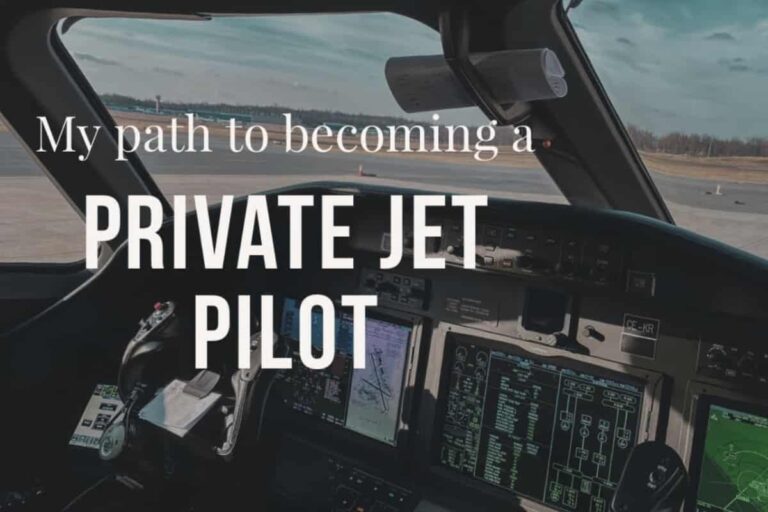How to Become a Private Jet Pilot? To become a private jet pilot, you must first obtain a Private Pilot License (PPL), followed by a Commercial Pilot License (CPL), and an Instrument Rating. The good news is that with the right training and dedication, you can achieve this goal.
In this blog, we will show you every step to become a private jet pilot. You’ll learn about licenses, costs, flight hours, and how to land your first job. By the end, you’ll have a clear path forward.
What Does a Private Jet Pilot Do?
A private jet pilot flies passengers to many different locations. You may land at small or remote airports that need careful flying skills. The schedule can change quickly, and you may fly at short notice. The job can be challenging, but it offers great experience and the chance to fly advanced aircraft.
Basic Requirements to Start
You must be at least 17 years old to get your Private Pilot License. All aviation authorities mandate that you be at least 17 to obtain a Private Pilot License. You need to speak, read, and understand English fluently. A high school diploma is the minimum requirement.
Before you can start flying, you must undergo a medical examination conducted by a licensed medical examiner. This exam checks your physical and mental health. You must pass vision and hearing tests. The medical certificate must be renewed regularly.
No college degree is required to become a pilot. However, many airlines and private jet companies prefer candidates with a college degree, so investing in your education can open more doors. Degrees in aviation, math, or physics provide a strong foundation.
Step-by-Step Training Path
Step 1: Get Your Private Pilot License (PPL)
Your journey starts here. The Private Pilot License allows you to fly as a pilot-in-command of an aircraft. You need at least 40 hours of flight time. This includes 20 hours with an instructor and 10 hours flying solo.
During your private pilot flight training, you will need to take and pass the computer-based FAA private pilot knowledge test. You’ll also take a practical exam with a Designated Pilot Examiner. This exam has both oral questions and a flight test.
The PPL course takes about three months if you train full-time. The total private pilot license cost in 2024 is normally between $16,000 and $21,000. Training costs vary by location and flight school.
Step 2: Earn Your Instrument Rating (IR)
An instrument rating enables you to fly by instrument flight rules when cloud heights and visibility are lower than what’s required for VFR operations. This rating is essential for private jet flying.
You need an additional 40 hours of instrument flight training. The Instrument Rating consists of classroom and flight instruction, a written exam, a practical exam, an oral test, and a flight test. It takes about two months to complete.
The cost is around $12,000 to $17,000. You’ll learn to fly using only cockpit instruments. This skill lets you fly in clouds and bad weather safely.
Step 3: Obtain Your Commercial Pilot License (CPL)
The Commercial Pilot License allows you to be compensated for your flying services. This is crucial if you want to work as a professional pilot.
You must accumulate 250 flight hours total. The CPL training will involve more advanced flying techniques and may include complex aircraft operations. The training costs between $10,000 and $24,000.
You’ll pass another written exam and practical flight test. The CPL covers night flying, cross-country flights, and advanced maneuvers. Most people take six to nine months to complete this step.
Step 4: Get Your Multi-Engine Rating
Many private jets are multi-engine aircraft, so obtaining a Multi-Engine Rating is essential. This rating teaches you to fly planes with more than one engine.
There’s no written test for this rating. You only need to pass a checkride. The cost ranges from $3,000 to $5,000. Training takes a few weeks.
This rating expands your job opportunities significantly. Nearly all private jets have multiple engines.
Step 5: Build Flight Hours
The FAA generally requires you to log a minimum of 1,500 total flight hours for a commercial pilot license. Many employers want even more experience before hiring you.
Being a Flight Instructor is probably the fastest way to build your flight time and get paid, especially if it is a large flight school. You can also work in cargo, charter operations, or aerial photography.
Building hours takes time and dedication. Some pilots spend two to three years accumulating the necessary experience. Your pilot has thousands of hours before ever being able to fly a jet aircraft.
Step 6: Obtain Type Ratings
To fly a jet, you will need to receive a type rating, which applies to a specific jet. Each jet model requires its own type rating.
Your employer usually pays for this training. Your jet training will take place at a facility specializing in certain aircraft types, usually lasting about an entire month. The training includes classroom time, procedures training, and full-motion simulator sessions.
Type rating courses cost between $5,000 and $15,000. You must pass both written and practical exams for each aircraft type.
Read Also: F-16 Ride Along
How Much Does Training Cost?
Training costs range from $70,000 to $100,000, including flight school fees, aircraft rental, and exam costs. Some programs cost more, especially at university-based schools.
Here’s a breakdown:
- Private Pilot License: $16,000 – $21,000
- Instrument Rating: $12,000 – $17,000
- Commercial Pilot License: $10,000 – $24,000
- Multi-Engine Rating: $3,000 – $5,000
- Flight Instructor Certificates: $10,000 – $15,000
- Additional endorsements and ratings: $2,000 – $5,000
It costs $116,995 to become a pilot when starting with no previous experience at ATP Flight School. This includes all certificates from private pilot through flight instructor.
You can reduce costs by training frequently. Flying only once a week or twice a month will kill your progress, and the total cost at the end will be less if you train three times a week.
How Long Does It Take?
The timeline depends on your schedule and dedication. If you train full-time, you can complete all requirements in 12 to 18 months. In total, it typically takes 1-3 years to get all the necessary licenses and experience to become a private jet pilot.
Part-time training takes longer, usually 2 to 4 years. The key is consistency. Regular training helps you retain skills and progress faster.
After getting your CPL, you’ll spend additional time building hours. If you’re aspiring to become a private jet pilot, many companies will require you to have an airline transport pilot certificate, which entails accumulating at least 1,500 flight hours. This phase can take 1 to 3 years.
Getting Your First Private Jet Job
Networking with private charter companies is a great way to have a foot in the door when they need to expand their operations or replace pilot turnover. Start building relationships early.
Research companies like NetJets, Flexjet, and Wheels Up. Look for smaller charter operators in your area. Corporate flight departments also hire private jet pilots.
Entry-level positions require 500 to 1,500 hours of experience. The industry is in such a unique place today that your first jet aircraft could be as large and complex as a Gulfstream IV or Falcon 900.
Prepare a professional resume highlighting your flight hours, ratings, and certifications. Emphasize customer service skills. Private jet pilots interact directly with high-profile passengers.
How Much Do Private Jet Pilots Earn?
On average, a private jet pilot’s salary is approximately $130,916 per year. However, salaries vary widely based on experience and location.
According to Indeed data from August 2024, private jet pilots earn $134,630 per year, on average. Entry-level pilots start around $70,000 to $90,000 annually. Experienced captains can earn $150,000 to $250,000 or more.
In New York City, average charter pilot salaries reach approximately $261,000, while corporate pilots average $215,000. Location matters significantly. Pilots in California, New York, and Florida earn the highest salaries.
Pilots flying on light aircraft such as the Cessna Citation CJ1 will have average salaries of around $90,000 and $100,000. Captains of large jets like the Gulfstream G650 can earn over $300,000 annually.
Private Jets vs. Airlines: Key Differences
Private aviation offers unique advantages. You enjoy more flexible schedules compared to airline pilots. You fly for a couple hours and then the people you transport go do their thing and you’re on your own. Some pilots bring golf clubs or explore local attractions during downtime.
The work is more personalized. You build relationships with regular clients. Private pilots shoulder more responsibility than airline pilots, who fly almost exclusively into massive airports with abundant operations infrastructure.
However, schedules can be unpredictable. You might be on call for extended periods. International flights and overnight trips are common. The job requires adaptability and professionalism.
Tips from Reddit and Pilot Communities
Pilots on forums recommend getting your CFI (Certified Flight Instructor) certificate early. This lets you build hours while earning money. If you can’t get a 1st Class Medical Certificate, you will not be able to acquire an ATP License, but if you qualify for a 2nd Class Medical you can still fly for hire with a Commercial Pilots License.
The real consideration is experience, which comes from spending time in the air making decisions, and handling the consequences. Don’t rush through training. Focus on building solid skills.
Join pilot communities online and attend aviation events. Connect with working pilots. Ask questions and learn from their experiences. Many pilots are happy to mentor newcomers.
Read Also: Are Jets Faster Than Planes?
Is It Worth It?
Becoming a private jet pilot requires significant investment in time and money. The training is challenging. The irregular schedule demands flexibility.
But the rewards are substantial. You earn a competitive salary. You travel to amazing destinations. The demand for business aviation pilots increases as the demand for the position outpaces the number of available and trained pilots. Job opportunities are growing.
With a global pilot shortage and steady demand for executive and luxury travel, private jet pilots are expected to remain well-compensated through 2025 and beyond. The career outlook is strong.
If you love flying and want a dynamic career, private aviation offers incredible opportunities. The path is clear. The choice is yours. For more information, visit Crew Daily.
Frequently Asked Questions
Q: What certifications are required to become a private jet pilot in the US?
You need a Private Pilot License, Instrument Rating, Commercial Pilot License, and Multi-Engine Rating at minimum. Private jet pilots need at least a commercial pilot certificate and the type rating for the aircraft they will be flying. Many employers also require an Airline Transport Pilot certificate.
Q: How much does it cost to get a private jet pilot license?
Training costs range from $70,000 to $100,000, including flight school fees, aircraft rental, and exam costs. Costs vary by location and flight school. At ATP Flight School, it costs $116,995 to become a pilot when starting with no previous experience.
Q: How long does it take to become a certified private jet pilot?
It typically takes 1-3 years to get all the necessary licenses and experience to become a private jet pilot, depending on your training schedule and commitment. Full-time training is faster than part-time schedules.
Q: How many hours do you need to become a private jet pilot?
The FAA generally requires you to log a minimum of 1,500 total flight hours for most professional positions. However, you must accumulate at least 250 hours of flying experience for the Commercial Pilot License. Some employers hire pilots with 500-1,000 hours for entry-level positions.
Q: Can you fly a private jet with just a Commercial Pilot License?
Yes, technically. To become a paid private jet pilot, you’ll need to obtain a commercial pilot license at the very least. However, most employers prefer pilots with more experience and an ATP certificate. You also need type ratings for specific aircraft.
Q: What’s the job market like for private jet pilots?
The market is strong. By 2021, private jet activity had grown by nearly 42% above pre-2020 levels with major operators posting double-digit gains in flight hours. The pilot shortage creates excellent opportunities for qualified candidates.
Q: Do I need a college degree to become a private jet pilot?
No. There are no strict educational requirements when considering how to become a pilot for private jets. However, many airlines and private jet companies prefer candidates with a college degree. A degree can provide a competitive advantage.
Q: What’s the fastest way to build flight hours?
Being a Flight Instructor is probably the fastest way to build your flight time and get paid, especially if it is a large flight school. Other options include cargo flying, aerial surveying, and charter operations. The key is finding any job that lets you log hours while earning income.


